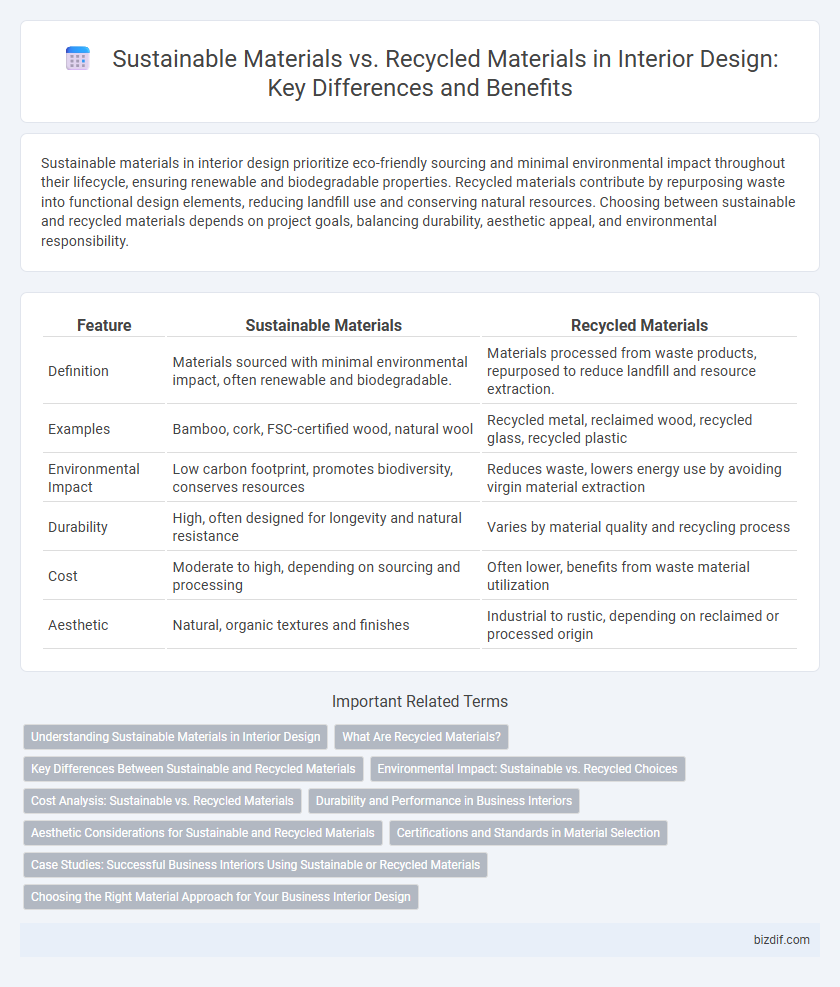Sustainable materials in interior design prioritize eco-friendly sourcing and minimal environmental impact throughout their lifecycle, ensuring renewable and biodegradable properties. Recycled materials contribute by repurposing waste into functional design elements, reducing landfill use and conserving natural resources. Choosing between sustainable and recycled materials depends on project goals, balancing durability, aesthetic appeal, and environmental responsibility.
Table of Comparison
| Feature | Sustainable Materials | Recycled Materials |
|---|---|---|
| Definition | Materials sourced with minimal environmental impact, often renewable and biodegradable. | Materials processed from waste products, repurposed to reduce landfill and resource extraction. |
| Examples | Bamboo, cork, FSC-certified wood, natural wool | Recycled metal, reclaimed wood, recycled glass, recycled plastic |
| Environmental Impact | Low carbon footprint, promotes biodiversity, conserves resources | Reduces waste, lowers energy use by avoiding virgin material extraction |
| Durability | High, often designed for longevity and natural resistance | Varies by material quality and recycling process |
| Cost | Moderate to high, depending on sourcing and processing | Often lower, benefits from waste material utilization |
| Aesthetic | Natural, organic textures and finishes | Industrial to rustic, depending on reclaimed or processed origin |
Understanding Sustainable Materials in Interior Design
Sustainable materials in interior design prioritize environmental responsibility by sourcing renewable, non-toxic, and biodegradable components that minimize ecological impact throughout their lifecycle. These materials, such as bamboo, cork, and natural fibers, support resource conservation and promote healthier indoor environments. Understanding sustainable materials enhances design decisions by balancing durability, aesthetics, and environmental stewardship for a more eco-conscious space.
What Are Recycled Materials?
Recycled materials in interior design consist of products repurposed from waste or used items, reducing the need for virgin resources and minimizing landfill impact. Common examples include reclaimed wood, recycled glass, and repurposed metal, which maintain structural integrity while promoting environmental responsibility. Using recycled materials supports circular economy principles, lowers carbon footprints, and enhances sustainable building practices in interior environments.
Key Differences Between Sustainable and Recycled Materials
Sustainable materials in interior design are sourced with minimal environmental impact, emphasizing renewable resources, responsible harvesting, and reduced carbon footprint, while recycled materials are specifically derived from repurposed waste products to prevent landfill accumulation. Sustainable options prioritize long-term ecological balance through life-cycle assessments and durability, whereas recycled materials focus on reusing existing substances regardless of their original production method. Understanding these key differences helps designers make informed choices that align with environmental goals and aesthetic functionality.
Environmental Impact: Sustainable vs. Recycled Choices
Sustainable materials in interior design, such as bamboo and cork, are sourced from rapidly renewable resources that minimize environmental degradation and carbon footprint. Recycled materials, including reclaimed wood and recycled metal, reduce landfill waste and lower the demand for virgin raw materials, conserving energy and reducing pollution. Choosing between sustainable and recycled materials depends on specific project goals, with both contributing significantly to environmentally responsible design practices.
Cost Analysis: Sustainable vs. Recycled Materials
Sustainable materials typically incur higher upfront costs due to ethical sourcing and eco-friendly production processes, while recycled materials often offer cost savings by repurposing existing resources and reducing manufacturing energy. The long-term financial benefits of sustainable materials include durability and reduced environmental impact, which can lower maintenance and replacement expenses. In contrast, recycled materials excel in minimizing waste management costs and promoting circular economy principles, making them a budget-friendly option for eco-conscious interior design projects.
Durability and Performance in Business Interiors
Sustainable materials used in business interiors often offer superior durability due to their natural composition and minimal processing, enhancing long-term performance while reducing environmental impact. Recycled materials contribute to resource efficiency by repurposing existing waste but may exhibit variable durability depending on the source and manufacturing process. Selecting high-quality sustainable or recycled materials tailored to office wear and tear ensures optimal performance, energy savings, and cost-effectiveness over the lifecycle of interior furnishings and fixtures.
Aesthetic Considerations for Sustainable and Recycled Materials
Sustainable materials in interior design offer natural textures and rich, organic colors enhancing visual warmth and authenticity. Recycled materials contribute unique patterns and eclectic character, often resulting in innovative and eye-catching aesthetic features. Both options support environmentally responsible design while allowing for creative expression through diverse material finishes and forms.
Certifications and Standards in Material Selection
Certifications such as FSC (Forest Stewardship Council) and Cradle to Cradle guide sustainable material selection by ensuring responsible sourcing and environmental impact reduction. Recycled materials often comply with standards like GREENGUARD and LEED credits, promoting indoor air quality and resource efficiency. Prioritizing certified materials enhances transparency and accountability in interior design projects focused on sustainability.
Case Studies: Successful Business Interiors Using Sustainable or Recycled Materials
Case studies of business interiors reveal that sustainable materials like bamboo and cork significantly reduce environmental impact while enhancing aesthetic appeal and durability in office spaces. Recycled materials, such as reclaimed wood and repurposed metal, demonstrate cost efficiency and unique design elements, showcased by brands like Patagonia's flagship store and Google's campus interiors. These examples highlight how integrating sustainable or recycled materials drives corporate social responsibility and improves occupant well-being through eco-friendly design practices.
Choosing the Right Material Approach for Your Business Interior Design
Sustainable materials in interior design emphasize renewable, low-impact resources such as bamboo, cork, and FSC-certified wood, offering durability and environmental responsibility. Recycled materials, including reclaimed wood, repurposed metals, and recycled glass, reduce waste by transforming discarded items into functional design elements. Selecting the right material approach involves evaluating project goals, budget constraints, and brand values to balance aesthetics, sustainability certifications, and long-term environmental impact.
Sustainable Materials vs Recycled Materials Infographic

 bizdif.com
bizdif.com